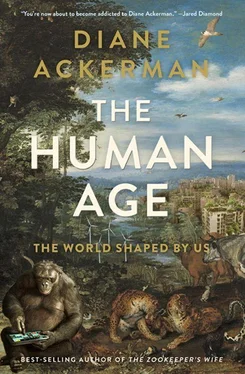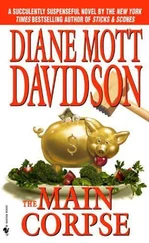How can a towering garden with a northern exposure survive the icy winds sweeping across the Seine? That’s where Blanc’s education and research as a botanist come in. The living wall is hardy because he’s chosen hundreds of understory species that he’s discovered can nonetheless tolerate slathers of direct light and wind.
“When I think of Heuchera ,” he says, referring to a family of plants that includes coral bells and alumroot, which produce small delicate flowers, and whose leaves are like hands with the fingers extended, “I always think of their leaves emerging intact from the melting snow in April, along the steep slopes in the shade of giant sequoias in California.”
Blanc works with a palette of deep rich greens in dozens of subtle shades and intensities, from asparagus and fern green to forest or praying mantis green, and textures that run the gamut from matte to hairy, spongy to sheen. All vary with time of day, age, season, clouds eclipsing the sun, fog rolling off the river, rush-hour traffic, aberrations of twilight. Seen through our rods and cones, the colors remix and evolve perpetually as they would if we encountered them in a forest. He prefers leaves to flowers, doesn’t care for trailing vines, and is sensitive to the architecture of leaves. The thousands of individual plants he quilts together grow leaves that are bristled, pointed, star-shaped, notched, oval, sickle-shaped, circular, teardrop, blunt, heart-shaped, arrow-headed, and more. Some climb while others descend, some mound or bloom daintily, others sprout or cantilever. Knowing the habit of each, he draws a multicelled planting map that looks like swirling fingerprints or a paint-by-number guide, with each segment a plant species referred to by Latin name. [8] Patrick Blanc, The Vertical Garden: From Nature to the City (New York: W. W. Norton, 2012), 76.
“They begin like paintings,” he explains. “Then they develop texture and depth.”
As a science-based art form, it’s a fusion inspired by many muses. The plants are drawn on flat paper, so each design does indeed begin like a painting. Then the artwork morphs into a sensuous sculpture of touchable, biological, prunable shapes and colors. Leaves, flowers, stems dance in the air, a slow-motion ballet. He may try to choreograph them to some degree, but the ensemble will succumb to wild swings of improvisation, depending on the weather. As frogs, birds, and insects take up residence, they’ll add a croaking-chirping-buzzing chorale, with some notes foreseeable and the rest jazz variations.
Although the plants naturally curve, clear lines and clean edges give the finished work a tone of sensuous elegance, not disarray. It’s lofty and complex, not cluttered. The plants aren’t exactly wild, but they can flourish in unique ways. In that sense, it’s more like chaos aligned—a deliberate, contained, carefully measured, masterfully executed free-for-all.
Practical botany, hydraulics, physics, and materials science are essential scaffolding for the artistry. Thousands of individual plants are inserted by hand into pockets on a flat felt sheet that’s rigidly framed and will be watered and fed, rain-style, by intermittent showers from a hidden pipe running across the top. Despite the lack of soil, the plants quickly flourish, covering the felt and pipe. The overall effect is a gulp of wild nature that hits you in the solar plexus. This is a garden you stand up and greet at eye level, as you would a person. It invites you to touch and smell it. Look up, and it looms four stories above you like an expansive forest understory, not a fairy-tale giant. Close in, it creates its own weather bubble and is quite shady and moist if you stand beside it and tilt up your chin at the dizzying vegetation. Balancing on a very thin wire between tame and free-willed, it seems both intimate and indomitable.
VERTICAL GARDENS, LIVING roofs, and urban farms are going mainstream everywhere. A few of my favorites: Mexico City’s towering arches carpeted in fifty thousand plants astride car-clogged avenues; the blooming brocade of native plants adorning the inner walls of the Dolce Vita shopping center in Lisbon; the glassed-in courtyard of Milan’s Café Trussardi, where a canopy of frizzy greens and purples floats above diners and cocktail-sipping flaneurs, trailing vines and flowers like a hint of heaven; the golden wheatfield atop the Canadian War Museum in Ottawa; nine sinuous houses buried under earth and grass in Dietikon, Switzerland; the Grange, atop two buildings in the Brooklyn Navy Yard, where you’re surrounded by organic vegetables and views of the Hudson. The roof of the Chicago Botanic Gardens’ Rice Plant Conservation Science Center doubles as a garden visited by millions of people and a botanical laboratory, and the roof of Chicago’s City Hall also serves as a study site, with the usual black tar on one side and a wildflower garden on the other. (On summer days, the ambient air above the planted side measures as much as 78°F cooler than the air over the old blacktop.) And living rooftops are becoming hot property. One U.S. company has already sold 1.2 million square feet of sprouting, blooming, bird-, bee-, and butterfly-enticing roofs, mainly to private residences.
Other living roofs and vertical garden companies have sprung up and begun greening all sorts of buildings, from hospitals, homes, and police stations to banks and offices. Some use hydroponic methods; others plant in turf on the roof à la the European tradition. A former Renault factory in Boulogne, France, has been reborn as a school with an undulating green-roof that reduces heating and cooling costs. The design firm Green over Grey, based in Vancouver, British Columbia, has created some spectacular living walls for sites in Canada, including the international building at Edmonton Airport, where arriving visitors inhale a shot of oxygen and plant-scrubbed fresh air from a gigantic living wall whose design swirls were inspired by high-altitude cloud formations. “Jungle Waterfall,” their dramatic, multistory cascade in an office building in Vancouver, includes tropical trees, and a maintenance crew occasionally has to harvest the pineapples lest they fall and hit passersby.
Planted walls and roofs and sustainably designed buildings, along with wildlife corridors, city parks, solar and wind power, and trees aglow with bioluminescent foliage (to replace streetlamps), are but a few of the initiatives gaining popularity in the U.K., Germany, Taiwan, the United States, and many other places worldwide. Roofs planted with sedums and succulents blossom, changing color with the seasons, while being low-maintenance, reflecting heat, and providing a habitat for birds. The goal is homes and public spaces that are living organisms that will scrub the air of pollutants, increase oxygen, reduce noise, save energy, refresh the spirit, and sink our roots deeper into the natural world.
IN CONTRAST TO Blanc’s elegantly formal walls for the Quai Branly and a similar project at the Athenaeum Hotel in London, his own house on the outskirts of Paris is a throbbing green Mardi Gras of microhabitats, with knolls of lance-shaped leaves, jutting rocks, prongs of tiny flowers, thick heart-shaped leaves, arrow-leafed philodendrons with roots adrift in a flowing stream. You don’t so much enter the abode he shares with his longtime partner, the actor Pascal Henri (a.k.a. “Pascal of Bollywood”), as join a green rhapsody, or possibly a green bedlam, and become part of the cascading carnival of fronds, mounds of moss, umbrellaing ferns, twig elbows, searching roots, and leafy limbs probing at everything, including you. The superabundance of leaves caresses you lightly with barely discernible veined fingers as you pass. Beaded curtains serve as doors, and free-flying coral-beaked waxbills wing from room to room. Bouncing frogs and slithering lizards roam the house at ease, eyes rotating, tongues occasionally unfurling like party favors. At a Magritte-like Surrealist window, a bushy shrub on the inside echoes its twin on the outside. Your eye shimmies. Inside, outside—who can say where they begin or end? Glass is only liquid sand, after all, and only ever in motion, hourglasslike, pouring so slowly that our eyes read it as solid.
Читать дальше












